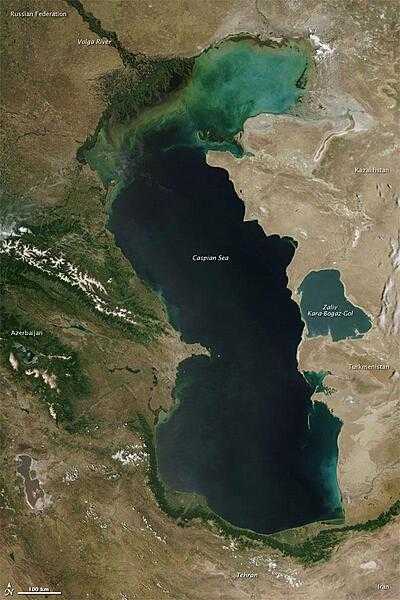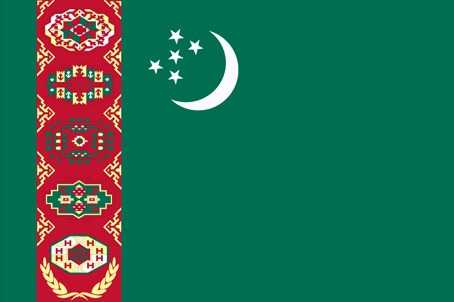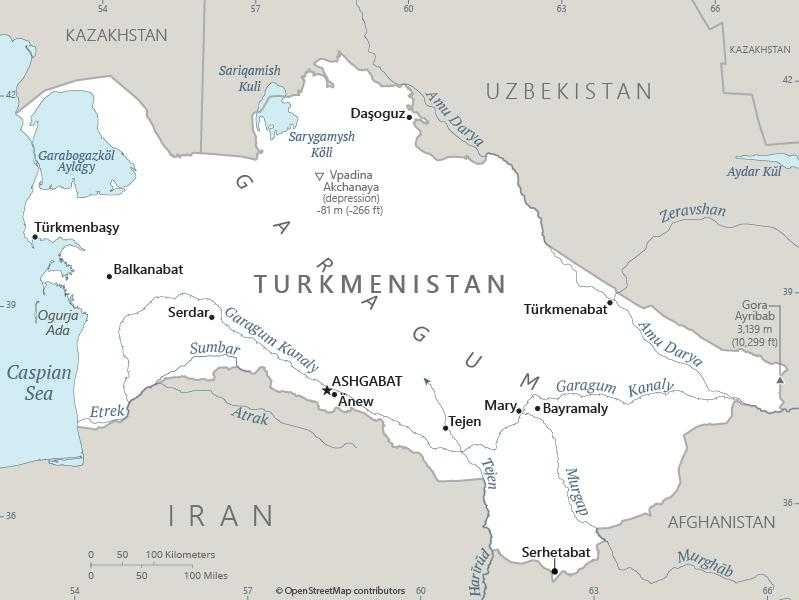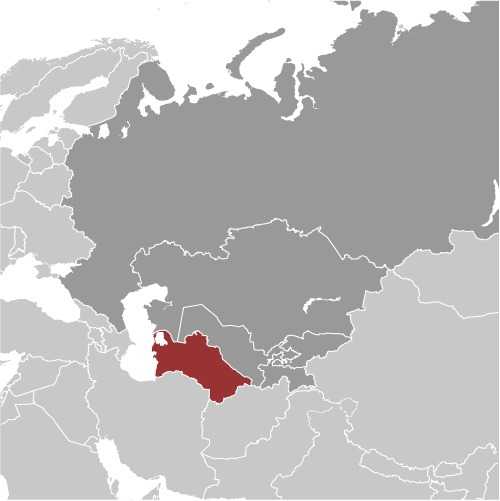Introduction
Background
Present-day Turkmenistan has been at the crossroads of civilizations for centuries. Various Persian empires ruled the area in antiquity, and Alexander the Great, Muslim armies, the Mongols, Turkic warriors, and eventually the Russians conquered it. In medieval times, Merv (located in present-day Mary province) was one of the great cities of the Islamic world and an important stop on the Silk Road. Annexed by Russia in the late 1800s, Turkmen territories later figured prominently in the anti-Bolshevik resistance in Central Asia. In 1924, Turkmenistan became a Soviet republic; it achieved independence when the USSR dissolved in 1991.
President for Life Saparmurat NIYAZOV died in 2006, and Gurbanguly BERDIMUHAMEDOV, a deputy chairman under NIYAZOW, emerged as the country's new president. BERDIMUHAMEDOV won Turkmenistan's first multi-candidate presidential election in 2007, and again in 2012 and 2017 with over 97% of the vote in elections widely regarded as undemocratic. In 2022, BERDIMUHAMEDOV announced that he would step down from the presidency and called for an election to replace him. His son, Serdar BERDIMUHAMEDOV, won the ensuing election with 73% of the vote. Gurbanguly BERDIMUHAMEDOV, although no longer head of state, maintains an influential political position as head of the Halk Maslahaty (People’s Council) and as National Leader of the Turkmen People, a title that provides additional privileges and immunity for him and his family. Since Gurbanguly BERDIMUHAMEDOV stepped down from the presidency, state-controlled media upgraded his honorific from Arkadag (protector) to Hero-Arkadag, and began referring to Serdar BERDIMUHAMEDOV as Arkadagly Serdar, which can be translated as "Serdar who has a protector to support him."
Turkmenistan has sought new export markets for its extensive hydrocarbon/natural gas reserves, which have yet to be fully exploited. Turkmenistan's reliance on gas exports has made the economy vulnerable to fluctuations in the global energy market, and economic hardships since the drop in energy prices in 2014 have led many citizens of Turkmenistan to emigrate, mostly to Turkey.
Visit the Definitions and Notes page to view a description of each topic.
Geography
Location
Central Asia, bordering the Caspian Sea, between Iran and Kazakhstan
Geographic coordinates
40 00 N, 60 00 E
Map references
Asia
Area - comparative
slightly more than three times the size of Georgia; slightly larger than California
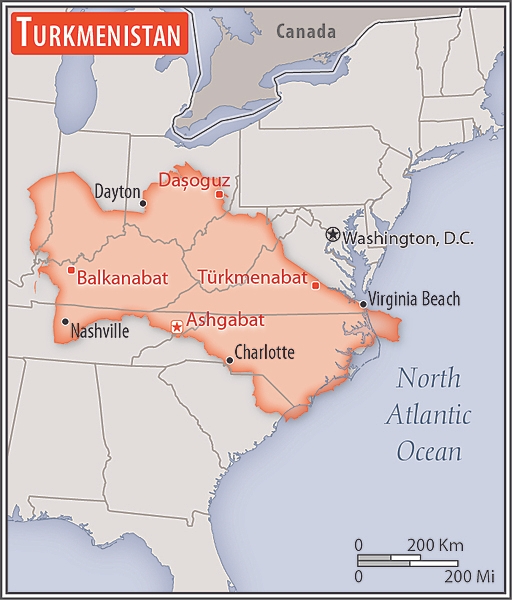
Land boundaries
total: 4,158 km
border countries (4): Afghanistan 804 km; Iran 1,148 km; Kazakhstan 413 km; Uzbekistan 1,793 km
Coastline
0 km (landlocked); note - Turkmenistan borders the Caspian Sea (1,768 km)
Maritime claims
none (landlocked)
Climate
subtropical desert
Terrain
flat-to-rolling sandy desert with dunes rising to mountains in the south; low mountains along border with Iran; borders Caspian Sea in west
Elevation
highest point: Gora Ayribaba 3,139 m
lowest point: Vpadina Akchanaya (Sarygamysh Koli is a lake in northern Turkmenistan with a water level that fluctuates above and below the elevation of Vpadina Akchanaya, the lake has dropped as low as -110 m) -81 m
mean elevation: 230 m
Natural resources
petroleum, natural gas, sulfur, salt
Land use
agricultural land: 72% (2018 est.)
arable land: 4.1% (2018 est.)
permanent crops: 0.1% (2018 est.)
permanent pasture: 67.8% (2018 est.)
forest: 8.8% (2018 est.)
other: 19.2% (2018 est.)
Irrigated land
19,950 sq km (2012)
Major lakes (area sq km)
salt water lake(s): Caspian Sea (shared with Iran, Azerbaijan, Russia, and Kazakhstan) - 374,000 sq km
Major rivers (by length in km)
Amu Darya (shared with Tajikistan [s], Afghanistan, and Uzbekistan [m]) - 2,620 km
note – [s] after country name indicates river source; [m] after country name indicates river mouth
Major watersheds (area sq km)
Internal (endorheic basin) drainage: (Aral Sea basin) Amu Darya (534,739 sq km)
Population distribution
the most densely populated areas are the southern, eastern, and northeastern oases; approximately 50% of the population lives in and around the capital of Ashgabat
Natural hazards
earthquakes; mudslides; droughts; dust storms; floods
Geography - note
landlocked; the western and central low-lying desolate portions of the country make up the great Garagum (Kara-Kum) desert, which occupies over 80% of the country; eastern part is plateau
People and Society
Population
total: 5,744,151
male: 2,842,870
female: 2,901,281 (2024 est.)
comparison rankings: female 116; male 116; total 116
Nationality
noun: Turkmenistani(s)
adjective: Turkmenistani
Ethnic groups
Turkmen 85%, Uzbek 5%, Russian 4%, other 6% (2003 est.)
Languages
Turkmen (official) 72%, Russian 12%, Uzbek 9%, other 7%
major-language sample(s):
Dünýä Faktlar Kitaby – esasy maglumatlaryň wajyp çeşmesidir (Turkmen)
The World Factbook, the indispensable source for basic information.
Religions
Muslim 93%, Christian 6.4%, Buddhist <1%, folk religion <1%, Jewish <1%, other <1%, unspecified <1% (2020 est.)
Demographic profile
While Turkmenistan reputedly has a population of more than 5.6 million, the figure is most likely considerably less. Getting an accurate population estimate for the country is impossible because then President Gurbanguly BERDIMUHAMEDOW withheld the results of the last two censuses. The 2012 census results reportedly show that nearly 2 million citizens have emigrated in the last decade, which prompted BERDIMUHAMEDOW to order another census. Results of this census, covering 2008-2018, also were not released to the public but purportedly are similar. Another census was held in December 2022.
Authorities have reacted to the dramatic population decline by preventing Turkmen from leaving the country, including removing citizens from international flights and refusing to provide necessary documents. Turkmenistan’s rise in outmigration – mainly to Turkey, Russia, and Uzbekistan – coincided with the country’s 2013-2014 economic crisis. The outflow has been sustained by poor living standards, inflation, low income, and a lack of health care. At the same time, Ashbagat is encouraging people to have more children to make up for its shrinking population.
Age structure
0-14 years: 24.5% (male 711,784/female 692,967)
15-64 years: 68.6% (male 1,956,740/female 1,984,333)
65 years and over: 6.9% (2024 est.) (male 174,346/female 223,981)
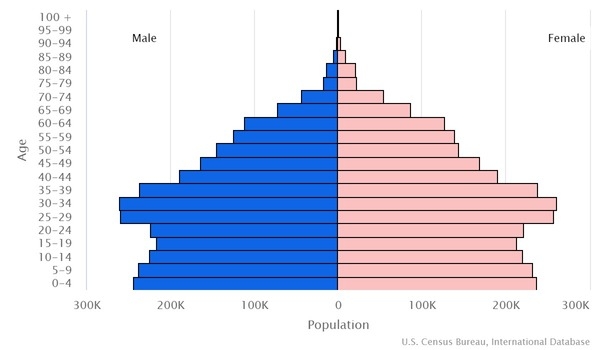
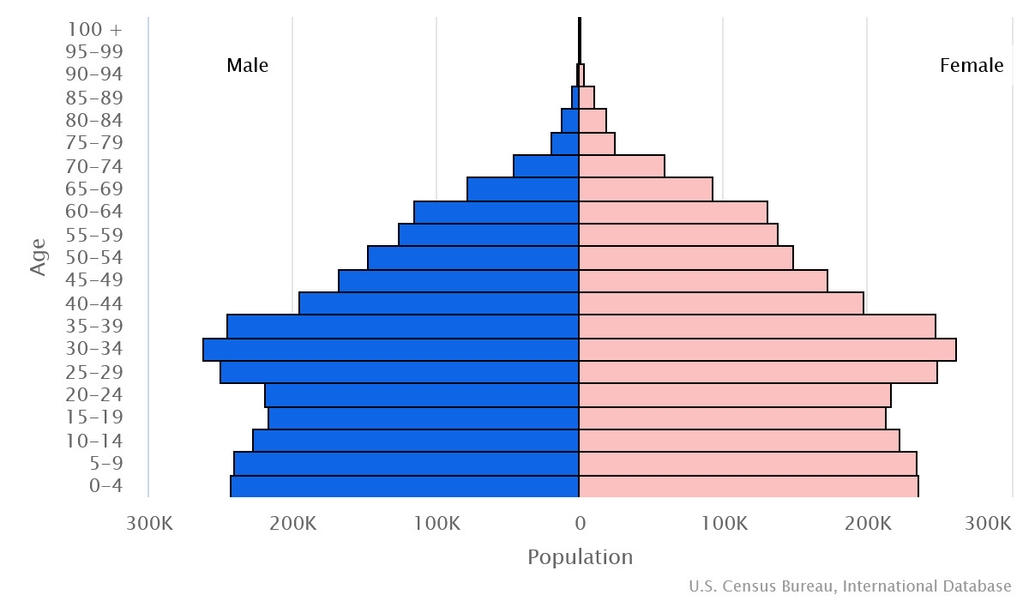
Dependency ratios
total dependency ratio: 56.6
youth dependency ratio: 48.9
elderly dependency ratio: 7.7
potential support ratio: 13 (2021 est.)
Median age
total: 31.2 years (2024 est.)
male: 30.7 years
female: 31.7 years
comparison ranking: total 128
Population distribution
the most densely populated areas are the southern, eastern, and northeastern oases; approximately 50% of the population lives in and around the capital of Ashgabat
Urbanization
urban population: 54% of total population (2023)
rate of urbanization: 2.23% annual rate of change (2020-25 est.)
Major urban areas - population
902,000 ASHGABAT (capital) (2023)
Sex ratio
at birth: 1.05 male(s)/female
0-14 years: 1.03 male(s)/female
15-64 years: 0.99 male(s)/female
65 years and over: 0.78 male(s)/female
total population: 0.98 male(s)/female (2024 est.)
Mother's mean age at first birth
24.2 years (2019)
Infant mortality rate
total: 35.9 deaths/1,000 live births (2024 est.)
male: 43.6 deaths/1,000 live births
female: 27.7 deaths/1,000 live births
comparison ranking: total 34
Life expectancy at birth
total population: 72.4 years (2024 est.)
male: 69.4 years
female: 75.5 years
comparison ranking: total population 162
Gross reproduction rate
0.99 (2024 est.)
Contraceptive prevalence rate
49.7% (2019)
Drinking water source
improved: urban: 100% of population
rural: 100% of population
total: 100% of population
unimproved: urban: 0% of population
rural: 0% of population
total: 0% of population (2020 est.)
Current health expenditure
5.7% of GDP (2020)
Physician density
2.23 physicians/1,000 population (2014)
Hospital bed density
4 beds/1,000 population (2014)
Sanitation facility access
improved: urban: 99.8% of population
rural: 99.9% of population
total: 99.8% of population
unimproved: urban: 0.2% of population
rural: 0.1% of population
total: 0.2% of population (2020 est.)
Alcohol consumption per capita
total: 2.88 liters of pure alcohol (2019 est.)
beer: 0.65 liters of pure alcohol (2019 est.)
wine: 1.25 liters of pure alcohol (2019 est.)
spirits: 0.98 liters of pure alcohol (2019 est.)
other alcohols: 0 liters of pure alcohol (2019 est.)
comparison ranking: total 117
Tobacco use
total: 5.5% (2020 est.)
male: 10.6% (2020 est.)
female: 0.4% (2020 est.)
comparison ranking: total 160
Currently married women (ages 15-49)
64.3% (2023 est.)
Child marriage
women married by age 15: 0.2%
women married by age 18: 6.1% (2019 est.)
Literacy
definition: age 15 and over can read and write
total population: 99.7%
male: 99.8%
female: 99.6% (2015)
School life expectancy (primary to tertiary education)
total: 13 years
male: 13 years
female: 13 years (2020)
Environment
Environment - current issues
contamination of soil and groundwater with agricultural chemicals, pesticides; salination, water logging of soil due to poor irrigation methods; Caspian Sea pollution; diversion of a large share of the flow of the Amu Darya into irrigation contributes to that river's inability to replenish the Aral Sea; soil erosion; desertification
Environment - international agreements
party to: Biodiversity, Climate Change, Climate Change-Kyoto Protocol, Climate Change-Paris Agreement, Comprehensive Nuclear Test Ban, Desertification, Hazardous Wastes, Ozone Layer Protection, Ship Pollution, Wetlands
signed, but not ratified: none of the selected agreements
Climate
subtropical desert
Land use
agricultural land: 72% (2018 est.)
arable land: 4.1% (2018 est.)
permanent crops: 0.1% (2018 est.)
permanent pasture: 67.8% (2018 est.)
forest: 8.8% (2018 est.)
other: 19.2% (2018 est.)
Urbanization
urban population: 54% of total population (2023)
rate of urbanization: 2.23% annual rate of change (2020-25 est.)
Air pollutants
particulate matter emissions: 26.41 micrograms per cubic meter (2019 est.)
carbon dioxide emissions: 70.63 megatons (2016 est.)
methane emissions: 52.09 megatons (2020 est.)
Waste and recycling
municipal solid waste generated annually: 500,000 tons (2013 est.)
Major lakes (area sq km)
salt water lake(s): Caspian Sea (shared with Iran, Azerbaijan, Russia, and Kazakhstan) - 374,000 sq km
Major rivers (by length in km)
Amu Darya (shared with Tajikistan [s], Afghanistan, and Uzbekistan [m]) - 2,620 km
note – [s] after country name indicates river source; [m] after country name indicates river mouth
Major watersheds (area sq km)
Internal (endorheic basin) drainage: (Aral Sea basin) Amu Darya (534,739 sq km)
Total water withdrawal
municipal: 450 million cubic meters (2020 est.)
industrial: 810 million cubic meters (2020 est.)
agricultural: 16.12 billion cubic meters (2020 est.)
Total renewable water resources
24.77 billion cubic meters (2020 est.)
Government
Country name
conventional long form: none
conventional short form: Turkmenistan
local long form: none
local short form: Turkmenistan
former: Turkmen Soviet Socialist Republic
etymology: the suffix "-stan" means "place of" or "country," so Turkmenistan literally means the "Land of the Turkmen [people]"
Government type
presidential republic; authoritarian
Capital
name: Ashgabat (Ashkhabad)
geographic coordinates: 37 57 N, 58 23 E
time difference: UTC+5 (10 hours ahead of Washington, DC, during Standard Time)
etymology: derived from the Persian words eshq meaning "love" and abad meaning "inhabited place" or "city," and so loosely translates as "the city of love"
Administrative divisions
5 provinces (velayatlar, singular - velayat) and 1 independent city*: Ahal Velayat (Arkadag), Ashgabat*, Balkan Velayat (Balkanabat), Dashoguz Velayat, Lebap Velayat (Turkmenabat), Mary Velayat
note: administrative divisions have the same names as their administrative centers (exceptions have the administrative center name following in parentheses)
Independence
27 October 1991 (from the Soviet Union)
National holiday
Independence Day, 27 October (1991)
Constitution
history: several previous; latest adopted 14 September 2016
amendments: proposed by the Assembly or Mejlis; passage requires two-thirds majority vote or absolute majority approval in a referendum; amended several times, last in 2023 (changed legislature from bicameral to unicameral Assembly or Mejlis; reestablished People's Council or Halk Maslahaty and named former president Gurbanguly BERDIMUHAMEDOV as National Leader of the Turkmen people
Legal system
civil law system with Islamic (sharia) law influences
International law organization participation
has not submitted an ICJ jurisdiction declaration; non-party state to the ICCt
Citizenship
citizenship by birth: no
citizenship by descent only: at least one parent must be a citizen of Turkmenistan
dual citizenship recognized: yes
residency requirement for naturalization: 7 years
Suffrage
18 years of age; universal
Executive branch
chief of state: President Serdar BERDIMUHAMEDOV (since 19 March 2022)
head of government: President Serdar BERDIMUHAMEDOV (since 19 March 2022)
cabinet: Cabinet of Ministers appointed by the president
elections/appointments: president directly elected by absolute majority popular vote in 2 rounds if needed for a 7-year term (no term limits); election last held on 12 March 2022 (next to be held in 2029); note - on 11 February 2022, President Gurbanguly BERDIMUHAMEDOV announced his intent to retire, setting up the early presidential election
election results:
2022: Serdar BERDIMUHAMEDOV elected president; percent of vote - Serdar BERDIMUHAMEDOW (DPT) 73%, Khydyr NUNNAYEV (independent) 11.1%, Agadzhan BEKMYRADOV (IAP) 7.2%, other 8.7%; note - Serdar BERDIMUHAMEDOV is the son of previous president Gurbanguly BERDIMUHAMEDOV
2017: Gurbanguly BERDIMUHAMEDOV reelected president in the first round; percent of vote - Gurbanguly BERDIMUHAMEDOW (DPT) 97.7%, other 2.3%
note: the president is both chief of state and head of government
Legislative branch
description: unicameral Assembly or Mejlis (125 seats; members directly elected in single-seat constituencies by absolute majority vote in 2 rounds if needed to serve 5-year terms); formerly the Assembly was the lower house of the bicameral National Council or Milli Genes, which consisted of an upper house, the People's Council or Halk Maslahaty, and the Assembly or Mejlis
elections: last held on 26 March 2023 (next to be held in 2028)
election results: percent of vote by party - NA; seats by party - DPT 55, APT 11, PIE 11, independent 48 (individuals nominated by citizen groups); composition men 93, women 32, percentage women 25.6%
note: on 22 January 2023, a joint session of the then bicameral National Council or Milli Genes voted unanimously to abolish itself, re-establishing a unicameral legislature and a separate People's Council or Halk Maslahaty
Judicial branch
highest court(s): Supreme Court of Turkmenistan (consists of the court president and 21 associate judges and organized into civil, criminal, and military chambers)
judge selection and term of office: judges appointed by the president for 5-year terms
subordinate courts: High Commercial Court; appellate courts; provincial, district, and city courts; military courts
Political parties and leaders
Agrarian Party of Turkmenistan or APT [Bashim ANNAGURBANOV]
Democratic Party of Turkmenistan or DPT [Ata SERDAROV]
Party of Industrialists and Entrepreneurs or PIE [Saparmurat OVGANOV]
note: all of these parties support President BERDIMUHAMEDOV; a law authorizing the registration of political parties went into effect in January 2012; unofficial, small opposition movements exist abroad
International organization participation
ADB, CIS (associate member, has not ratified the 1993 CIS charter although it participates in meetings and held the chairmanship of the CIS in 2012), EAPC, EBRD, ECO, FAO, G-77, IBRD, ICAO, ICRM, IDA, IDB, IFC, IFRCS, ILO, IMF, IMO, Interpol, IOC, IOM (observer), ISO (correspondent), ITU, MIGA, NAM, OIC, OPCW, OSCE, PFP, UN, UNCTAD, UNESCO, UNHCR, UNIDO, UNWTO, UPU, WCO, WFTU (NGOs), WHO, WIPO, WMO
Diplomatic representation in the US
chief of mission: Ambassador Meret ORAZOV (since 14 February 2001)
chancery: 2207 Massachusetts Avenue NW, Washington, DC 20008
telephone: [1] (202) 588-1500
FAX: [1] (202) 588-1500
email address and website:
turkmenembassyus@verizon.net
https://usa.tmembassy.gov.tm/en
Diplomatic representation from the US
chief of mission: Ambassador Matthew S. KLIMOW (since 26 June 2019)
embassy: 9 1984 Street (formerly Pushkin Street), Ashgabat 744000
mailing address: 7070 Ashgabat Place, Washington, DC 20521-7070
telephone: [993] (12) 94-00-45
FAX: [993] (12) 94-26-14
email address and website:
ConsularAshgab@state.gov
https://tm.usembassy.gov/
Flag description
green field with a vertical red stripe near the hoist side, containing five tribal guls (designs used in producing carpets) stacked above two crossed olive branches; five white, five-pointed stars and a white crescent moon appear in the upper corner of the field just to the fly side of the red stripe; the green color and crescent moon represent Islam; the five stars symbolize the regions or welayats of Turkmenistan; the guls reflect the national identity of Turkmenistan where carpet-making has long been a part of traditional nomadic life
note: the flag of Turkmenistan is the most intricate of all national flags
National symbol(s)
Akhal-Teke horse; national colors: green, white
National anthem
name: "Garassyz, Bitarap Turkmenistanyn" (Independent, Neutral, Turkmenistan State Anthem)
lyrics/music: collective/Veli MUKHATOV
note: adopted 1997, lyrics revised in 2008, to eliminate references to deceased President Saparmurat NYYAZOW
National heritage
total World Heritage Sites: 5 (4 cultural, 1 natural)
selected World Heritage Site locales: Ancient Merv (c); Kunya-Urgench (c); Parthian Fortresses of Nisa (c); Cold Winter Deserts of Turan (n); Silk Roads: Zarafshan-Karakum Corridor (c)
Economy
Economic overview
upper middle-income Central Asian economy; has 10% of global natural gas reserves, exporting to Russia and China; natural resource rich; authoritarian and dominated by state-owned enterprises; major central-south Asian pipeline development
Real GDP (purchasing power parity)
$94.79 billion (2022 est.)
$93.205 billion (2021 est.)
$89.192 billion (2020 est.)
note: data in 2017 dollars
comparison ranking: 98
Real GDP growth rate
6.3% (2023 est.)
6.2% (2022 est.)
6.2% (2021 est.)
note: annual GDP % growth based on constant local currency
comparison ranking: 29
Real GDP per capita
$14,700 (2022 est.)
$14,700 (2021 est.)
$14,300 (2020 est.)
note: data in 2017 dollars
comparison ranking: 127
GDP (official exchange rate)
$59.887 billion (2023 est.)
note: data in current dollars at official exchange rate
GDP - composition, by sector of origin
agriculture: 7.5% (2017 est.)
industry: 44.9% (2017 est.)
services: 47.7% (2017 est.)
comparison rankings: services 189; industry 18; agriculture 105
GDP - composition, by end use
household consumption: 50% (2017 est.)
government consumption: 10% (2017 est.)
investment in fixed capital: 28.2% (2017 est.)
investment in inventories: 0% (2017 est.)
exports of goods and services: 26.2% (2017 est.)
imports of goods and services: -14.3% (2017 est.)
Agricultural products
milk, cotton, wheat, potatoes, watermelons, tomatoes, grapes, beef, sugar beets, lamb/mutton (2022)
note: top ten agricultural products based on tonnage
Industries
natural gas, oil, petroleum products, textiles, food processing
Industrial production growth rate
4.3% (2014 est.)
note: annual % change in industrial value added based on constant local currency
comparison ranking: 58
Labor force
2.163 million (2023 est.)
note: number of people ages 15 or older who are employed or seeking work
comparison ranking: 124
Unemployment rate
4.12% (2023 est.)
4.12% (2022 est.)
4.45% (2021 est.)
note: % of labor force seeking employment
comparison ranking: 81
Youth unemployment rate (ages 15-24)
total: 11% (2021 est.)
male: 13.4%
female: 7.6%
comparison ranking: total 146
Population below poverty line
0.2% (2012 est.)
Average household expenditures
on food: 36.9% of household expenditures (2021 est.)
on alcohol and tobacco: 2.2% of household expenditures (2021 est.)
Household income or consumption by percentage share
lowest 10%: 2.6%
highest 10%: 31.7% (1998)
Remittances
0% of GDP (2022 est.)
0% of GDP (2021 est.)
0% of GDP (2020 est.)
note: personal transfers and compensation between resident and non-resident individuals/households/entities
Budget
revenues: $5.954 billion (2019 est.)
expenditures: $6.134 billion (2019 est.)
Current account balance
-$4.359 billion (2017 est.)
-$7.207 billion (2016 est.)
comparison ranking: 176
Exports
$10.282 billion (2021 est.)
$8.164 billion (2020 est.)
$11.188 billion (2019 est.)
note: GDP expenditure basis - exports of goods and services in current dollars
comparison ranking: 115
Exports - partners
China 71%, Turkey 7%, Uzbekistan 5%, Azerbaijan 4%, Morocco 2% (2022)
note: top five export partners based on percentage share of exports
Exports - commodities
natural gas, refined petroleum, fertilizers, crude petroleum, electricity (2022)
note: top five export commodities based on value in dollars
Imports
$6.25 billion (2021 est.)
$8.301 billion (2020 est.)
$8.844 billion (2019 est.)
note: GDP expenditure basis - imports of goods and services in current dollars
comparison ranking: 141
Imports - partners
UAE 27%, Turkey 24%, China 19%, Kazakhstan 7%, Germany 4% (2022)
note: top five import partners based on percentage share of imports
Imports - commodities
broadcasting equipment, cars, wheat, computers, iron structures (2022)
note: top five import commodities based on value in dollars
Reserves of foreign exchange and gold
$24.91 billion (31 December 2017 est.)
$25.05 billion (31 December 2016 est.)
comparison ranking: 59
Debt - external
$539.4 million (31 December 2017 est.)
$425.3 million (31 December 2016 est.)
comparison ranking: 177
Exchange rates
Turkmenistani manat (TMM) per US dollar -
Exchange rates:
4.125 (2017 est.)
3.5 (2016 est.)
3.5 (2015 est.)
3.5 (2014 est.)
2.85 (2013 est.)
Energy
Electricity access
electrification - total population: 100% (2022 est.)
Electricity
installed generating capacity: 5.202 million kW (2022 est.)
consumption: 16.977 billion kWh (2022 est.)
exports: 3.201 billion kWh (2022 est.)
transmission/distribution losses: 2.892 billion kWh (2022 est.)
comparison rankings: transmission/distribution losses 137; exports 44; consumption 81; installed generating capacity 89
Electricity generation sources
fossil fuels: 100% of total installed capacity (2022 est.)
Coal
imports: 100 metric tons (2022 est.)
proven reserves: 799.999 million metric tons (2022 est.)
Petroleum
total petroleum production: 272,000 bbl/day (2023 est.)
refined petroleum consumption: 152,000 bbl/day (2022 est.)
crude oil estimated reserves: 600 million barrels (2021 est.)
Natural gas
production: 86.472 billion cubic meters (2022 est.)
consumption: 41.561 billion cubic meters (2022 est.)
exports: 44.567 billion cubic meters (2022 est.)
proven reserves: 11.327 trillion cubic meters (2021 est.)
Carbon dioxide emissions
101.442 million metric tonnes of CO2 (2022 est.)
from petroleum and other liquids: 19.91 million metric tonnes of CO2 (2022 est.)
from consumed natural gas: 81.532 million metric tonnes of CO2 (2022 est.)
comparison ranking: total emissions 40
Communications
Telephones - fixed lines
total subscriptions: 802,000 (2021 est.)
subscriptions per 100 inhabitants: 13 (2021 est.)
comparison ranking: total subscriptions 77
Telephones - mobile cellular
total subscriptions: 6.255 million (2021 est.)
subscriptions per 100 inhabitants: 99 (2021 est.)
comparison ranking: total subscriptions 116
Telecommunication systems
general assessment: the nation of Turkmenistan, which rivals only North Korea for its isolationism, continues to keep its telecom sector along with the broader populace under tight control; the country inched up just one point off the bottom of the world rankings for press and internet freedom in the most recent report from Reporters Without Borders; most social networks in the country are blocked, although locals do have access to the government-developed platform released in 2019; all internet users, however, need to identify themselves before logging on, and strict censorship over what can be viewed is in force; the end result is that Turkmenistan has one of the lowest usage rates for internet access in the world (2024)
domestic: fixed-line is 13 per 100 and mobile-cellular teledensity is 99 per 100 persons (2022)
international: country code - 993; linked by fiber-optic cable and microwave radio relay to other CIS republics and to other countries by leased connections to the Moscow international gateway switch; an exchange in Ashgabat switches international traffic through Turkey via Intelsat; satellite earth stations - 1 Orbita and 1 Intelsat (2018)
Broadcast media
broadcast media is government controlled and censored; 7 state-owned TV and 4 state-owned radio networks; satellite dishes and programming provide an alternative to the state-run media; officials sometimes limit access to satellite TV by removing satellite dishes
Internet users
total: 1,563,023 (2022 est.)
percent of population: 25.3% (2022 est.)
comparison ranking: total 143
Broadband - fixed subscriptions
total: 10,000 (2020 est.)
subscriptions per 100 inhabitants: 0.2 (2020 est.)
comparison ranking: total 180
Transportation
National air transport system
number of registered air carriers: 1 (2020)
inventory of registered aircraft operated by air carriers: 27
annual passenger traffic on registered air carriers: 2,457,474 (2018)
annual freight traffic on registered air carriers: 16.92 million (2018) mt-km
Heliports
25 (2024)
Pipelines
7,500 km gas, 1501 km oil (2013)
Railways
total: 5,113 km (2017)
broad gauge: 5,113 km (2017) 1.520-m gauge
comparison ranking: total 37
Waterways
1,300 km (2011) (Amu Darya River and Kara Kum Canal are important inland waterways)
comparison ranking: 59
Merchant marine
total: 73 (2023)
by type: general cargo 6, oil tanker 8, other 59
comparison ranking: total 106
Military and Security
Military and security forces
Armed Forces of Turkmenistan (aka Turkmen National Army): Land Forces, Navy, Air and Air Defense Forces
Ministry of Internal Affairs: Internal Troops, national police, Federal/State Border Guard Service (2023)
Military expenditures
1.9% of GDP (2019 est.)
1.8% of GDP (2018 est.)
1.8% of GDP (2017 est.)
1.8% of GDP (2016 est.)
1.5% of GDP (2015 est.)
comparison ranking: 75
Military and security service personnel strengths
information varies; estimated 35,000 active-duty troops (30,000 Army; 1,000 Navy; 4,000 Air and Air Defense Forces) (2023)
Military equipment inventories and acquisitions
the inventory for Turkmenistan's military is comprised largely of older Russian and Soviet-era weapons systems; in recent years however, it has attempted to diversify and purchased equipment from more than a dozen countries, with China, Italy, and Turkey as the top suppliers (2023)
Military service age and obligation
18-27 years of age for compulsory military service for men; 24-month conscript service obligation (30 months for the Navy); 20 years of age for voluntary service for men and women; men may enroll in military schools from age 15 (2023)
Military - note
the military is responsible for external defense and works closely with the Border Service on protecting the country’s borders; it is conscript-based and equipped with Soviet-era arms; while Turkmenistan has a policy of permanent and "positive" neutrality and has declined to participate in post-Soviet military groupings such as the Collective Security Treaty Organization and the Shanghai Cooperation Organization, it has participated in multinational exercises and bilateral training with neighboring countries, including Russia and Uzbekistan; Turkmenistan joined NATO's Partnership for Peace program in 1994, but it does not offer any military forces to NATO-led operations
in recent years, Turkmenistan has made efforts to strengthen its naval capabilities on the Caspian Sea, including expanding ship building capabilities and adding larger vessels to the Navy’s inventory; in 2018, Turkmenistan opened its first naval shipyard, and in 2021 the Navy commissioned its largest warship, a corvette that was jointly constructed with Turkey, to complement a small existing force of coastal patrol craft (2023)
Space
Space agency/agencies
Turkmenistan National Space Agency (established 2011; in 2019, was transferred to the Space Directorate of Turkmenaragatnashik Agency) (2024)
Space program overview
has a small space program focused on acquiring satellites and developing the infrastructure to build and operate satellites; particularly interested in remote sensing satellites for such purposes as monitoring its agricultural and transportation sectors, the oil and natural gas industry, and the ecology of the Caspian Sea; has cooperated with the space agencies and/or space industries of France, Italy, Russia, South Korea, and the US (2024)
note: further details about the key activities, programs, and milestones of the country’s space program, as well as government spending estimates on the space sector, appear in the Space Programs reference guide
Transnational Issues
Refugees and internally displaced persons
stateless persons: 4,463 (2022)
Trafficking in persons
tier rating: Tier 3 — Turkmenistan does not fully meet the minimum standards for the elimination of trafficking and is not making significant efforts to do so, therefore, Turkmenistan remained on Tier 3; the government took some steps to address trafficking, including granting access to an international organization to monitor the cotton harvest, providing support for anti-trafficking campaigns, and training officials in collaboration with international organizations; however, a government policy or pattern of forced labor, including mobilization of adults for forced labor in the annual cotton harvest, public works, and other sectors, continued; the government did not report any investigations, prosecutions, or convictions, nor hold any officials accountable for complicity in forced labor crimes; authorities did not identify victims or fund victim assistance programs (2023)
Illicit drugs
transit country for Afghan opiates to Turkish, Russian, and European markets, either directly from Afghanistan or through Iran; not a major producer or source country for illegal drugs or precursor chemicals
